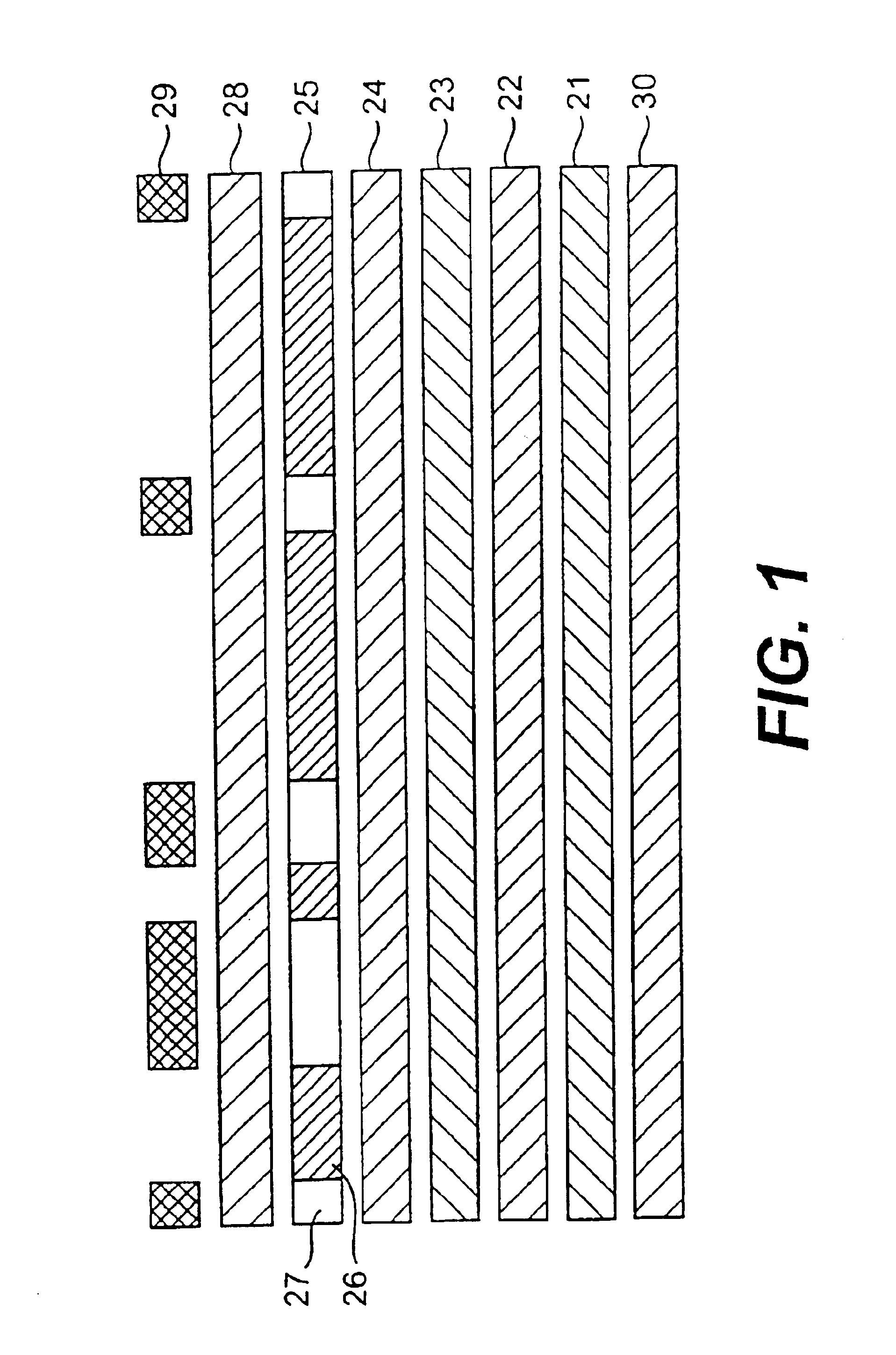Image transfer sheet with transfer blocking overcoat and heat transfer process using the same
a technology of image transfer and heat transfer process, which is applied in the direction of transportation and packaging, thermography, synthetic resin layered products, etc., can solve the problems of reducing the esthetic appeal of the transfer image, the image prepared by conventional screen printing followed by dry heat transfer to a cloth substrate is often cracked and peeling from the substrate with repeated laundering, and the effect of cost saving
- Summary
- Abstract
- Description
- Claims
- Application Information
AI Technical Summary
Benefits of technology
Problems solved by technology
Method used
Image
Examples
example 1
In one embodiment of the invention, the barrier layer is a vinyl acetate polymer. An example of this embodiment is Barrier Layer Formulation 1:
Barrier Layer Formulation 1ComponentsPartsVinyl acetate-dibutyl maleate50 partspolymer dispersion (such asEVERFLEX G, Hampshire ChemicalCorporation)Water50 parts.
Barrier Layer Formulation 1 may be prepared as follows: fifty parts of a vinyl acetate-dibutyl maleate polymer dispersion are combined with fifty parts of water by gentle stirring. The stirring is continued for approximately ten minutes at a moderate stir rate (up to but not exceeding a rate where cavitation occurs). The amount of water added may vary. The only limitation is that sufficient water is added to make the dispersion coatable on the substrate.
example 2
An example of the PMMA-containing barrier layer is Barrier Layer Formulation 2:
Barrier Layer Formulation 2ComponentsPartsAcetone40 parts (weight)99.5%2-Propanol40 parts (weight)99.5%PMMA20 parts (weight).
Barrier Layer Formulation 2 may be prepared as follows: The acetone and 2-propanol are weighed and mixed. The mixture is stirred. One half of the PMMA is added to the mixture while the mixture is heated to about 25° C. and stirring continues until the PMMA is dispersed. At this point, stirring continues until the remainder of the PMMA is added to the mixture and is dispersed. The mixture is then allowed to cool to room temperature.
example 3
This example relates to a release layer formulation. This is referred to as Release Layer Formulation 1:
Release Layer Formulation 1ComponentsParts by weightEthylene Acrylic Acid86partsCo-polymer Dispersion(Michem Prime 4983R, Michelman)Elastomeric emulsion5parts(Hystretch V-29, B F Goodrich)Polyurethane Dispersion (Daotan4partsVTW 1265, Vianova Resins)Polyethylene Glycol (Carbowax4partsPolyethylene Glycol 400,Union Carbide)Polyethylene Glycol Mono1part((Tetramethylbutyl) Phenol)Ether (Triton X-100, UnionCarbide)
Release Layer Formulation 1, as an embodiment of the invention suitable for laser copiers and laser printers, is wax free. Release Layer Formulation 1 may be prepared as follows: five parts of the elastomer dispersion are combined with eighty-six parts of an ethylene acrylic acid co-polymers dispersion by gentle stirring to avoid cavitation. Four parts of a polyurethane dispersion are then added to the mixture. Immediately following the addition of a polyurethane dispersion, ...
PUM
| Property | Measurement | Unit |
|---|---|---|
| pressure | aaaaa | aaaaa |
| temperature | aaaaa | aaaaa |
| pressure | aaaaa | aaaaa |
Abstract
Description
Claims
Application Information
 Login to View More
Login to View More - R&D
- Intellectual Property
- Life Sciences
- Materials
- Tech Scout
- Unparalleled Data Quality
- Higher Quality Content
- 60% Fewer Hallucinations
Browse by: Latest US Patents, China's latest patents, Technical Efficacy Thesaurus, Application Domain, Technology Topic, Popular Technical Reports.
© 2025 PatSnap. All rights reserved.Legal|Privacy policy|Modern Slavery Act Transparency Statement|Sitemap|About US| Contact US: help@patsnap.com



